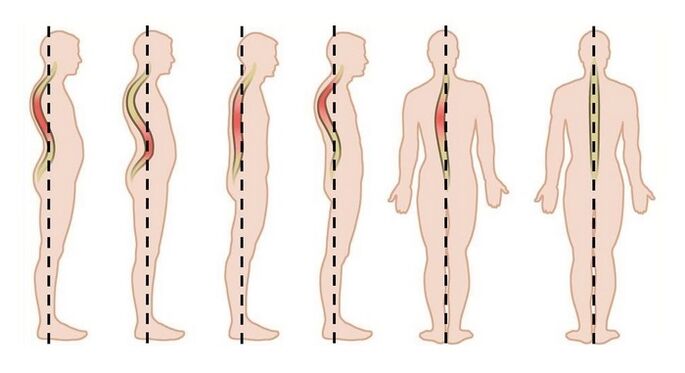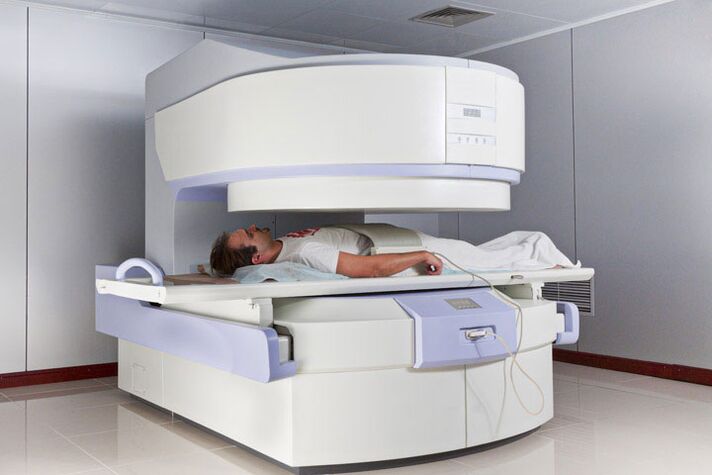
Osteochondrosis is one of the most commonly diagnosed diseases of the spine. This pathology has a degenerative-dystrophic origin, affects the intervertebral discs, which leads to their structural and external changes. Doctors define three types of the disease: cervical, thoracic, and lumbar osteochondrosis, depending on the location of the disease in the spine. If we talk about the statistics of the identified pathologies, then it is believed that thoracic osteochondrosis is less common than other types. This is due to the peculiarities of the structure of the human spine in the thoracic area: the intervertebral discs of this part of the back have limited mobility, which significantly reduces the likelihood of their traumatic injury.
What is Thoracic Osteochondrosis?
Identification of the disease is difficult, since its symptoms often resemble pathological changes in other organs: heart, stomach, etc. Thoracic osteochondrosis is dangerous in its consequences, therefore its early detection gives more chances for timely correction and prevention of undesirable consequences. The disease is diagnosed with equal frequency in people of both sexes of different ages, including children. Let's dwell in more detail on the causes of breast osteochondrosis, its symptoms, methods of treatment with drugs and at home.
Osteochondrosis of the thoracic spine is manifested as degenerative-dystrophic disorders in the structure of the bone, cartilage tissue of the vertebrae, which provokes the development of destructive processes in them. In addition to the vertebrae themselves, the intervertebral discs suffer: they layer themselves, decrease in size, as a result of which the nerve endings are pinched in the intercostal space. All of this together affects the normal functioning of the spine. Treatment, started at the wrong time, aggravates the situation, which is subsequently resolved solely with the help of surgical intervention, which for various reasons cannot always be resolved by the patient.
Osteochondrosis of the breast can provoke the development of quite serious and dangerous diseases and conditions. It often becomes the cause of pneumosclerosis, narrowing of blood vessels, dysfunction of the genitourinary system, cancer, etc. When osteochondrosis progresses rapidly, it usually limits a person's physical ability: it is difficult for them to walk, work, and walk freelyActivities.
In the development of osteochondrosis in patients, the bone portion of the vertebrae is affected first, then the cartilage, and finally the connective tissue and adjacent muscles.
If signs of osteochondrosis appear in childhood or adolescence, adolescence, it is a dangerous situation, as it suggests that the person's musculoskeletal system began to age without being fully formed and developed. Osteochondrosis of the thoracic spine in a child is rarely diagnosed. However, the disease detected often indicates that it is another dangerous disease.
Pathology is found approximately equally often in men and women. There are also no age-specific priorities. However, it is worth noting that during the hormonal changes in the body - menopause - women are more susceptible to the disease.
If you start treatment for thoracic spine osteochondrosis at an early stage, there is a much better chance that therapy will produce a positive result.
The degree of the disease and characteristic symptoms
The development of osteochondrosis of the thoracic spine is gradual, several stages are different. For the correct organization of the treatment process, it is necessary to understand the mechanisms of its development and course.
- The initial stage of degenerative-dystrophic processes in the spine is characterized by a slight decrease in the size of the intervertebral discs. Small cracks appear on the surfaces of the annulus fibrosus of the intervertebral discs. The intervertebral disc can lie a little outside the spine. At the same time, thoracic osteochondrosis of the first degree does not manifest itself as painful sensations, often a person is not aware of the onset of a dangerous disease. With the help of computed tomography, a protrusion of the intervertebral discs (their slight loss) is determined.
- When a person has 2nd degree thoracic osteochondrosis, painful manifestations appear in the back in the chest area. This is explained by the fact that nerve fibers are pinched. The muscular-ligament apparatus of the back, i. H. Muscle corset, provides optimal support for the spine in the correct anatomical shape. To prevent spinal instability, it is extremely important to make the muscle structures of the back symmetrical. Otherwise, there will be not only a violation of posture, curvature of the spine, but also excessive mobility of its individual elements. Due to the increased mobility of the vertebrae, the nerve fibers that leave the spine through the intervertebral space are pinched. How is osteochondrosis manifested in the second stage? Back pain in the second stage of thoracic osteochondrosis necessarily occurs. It has different properties: it can drag in the form of seizures over a long period of time or in the short term. To make matters worse, the nerve endings are compressed directly in the muscles, which are regularly in an increased tone.
- Morphological signs of third-degree thoracic osteochondrosis are very pronounced, they affect all structural anatomical components of the spine. The patient has the following pathological picture: there are hernias and protrusions of the intervertebral discs, muscles and ligaments become inflamed, cracks appear, the vertebrae are displaced, signs of osteoarthritis of the vertebral joints develop. The clinical picture of the spinal column disease in the third stage is very diverse. In addition to the fact that a person actually has pain with osteochondrosis of the chest, the patient loses tactile response of the part of the body where the damaged nerve passes; he has disorders of the autonomic nervous system, which are accompanied by disorders of the respiratory and circulatory systems. It becomes difficult for him to breathe, there is pain in the heart, irregular heartbeat, shortness of breath. In addition, the patient develops osteoarthritis of several joints at the same time, and pathological disorders in the functioning of the organs in the chest area begin. Similar symptoms appear when the intervertebral gap decreases by two-thirds of its height. Its size is assessed by a chest x-ray, which is done in two projections: straight and sideways.
- With the development of degenerative processes in the spine to osteochondrosis of the fourth degree, the intervertebral gap narrows to a minimal distance, dangerous conditions such as spondylosis, spondyloarthrosis (characterized by pathological changes in the intervertebral joints), spondylolisthesis (the vertebrae are twisted or displaced) develop. The body mobilizes its compensatory abilities to reduce the static and dynamic load on the spine in order to avoid injuries to anatomical elements that cause the vertebrae to grow, flatten and fuse together. The damaged area of the annulus fibrosus is replaced by a bone structure, osteophytes (bone outgrowths) form, the spinal cord narrows due to the herniated disc, nerve endings are severely compressed, the motor activity of the thoracic spine is severely restricted, the person is constantly in pain in the chest area ofrear.
- As a result of the progression of the disease, the patient has lower back pain (lumbago), the legs are completely or partially paralyzed, the person loses the ability to work, becomes disabled.
Different symptomatic manifestations of the disease depend on various reasons, including a person's genetic predisposition. The same symptoms of thoracic osteochondrosis fail in different ways in different patients. There is an objective explanation for this: Various causes, development conditions and the general state of health of humans lead to osteochondrosis. Symptoms of thoracic osteochondrosis appear a little earlier in men than in women. The main reason for this phenomenon lies in the physiological structure of the female body: the hormone estrogen protects the intervertebral discs, so changes in the hormonal background (during pregnancy, menopause) create particularly favorable conditions for the disease.
Many are interested in whether to join the army with osteochondrosis. If the conscript has first degree osteochondrosis, he is drafted into the military. If a young man has a pronounced symptomatology of the disease and is observed by a neuropathologist, then a delay in a neglected state is likely (with polysegmental osteochondrosis of the thoracic spine) they can not call at all.
Reasons for appearing
Thoracic osteochondrosis at the beginning of its onset manifests itself practically in nothing. However, you need to know why it might appear. The following reasons provoke pathology:
- Regular static or dynamic overuse of the spine through active strength training in competitive athletes or those doing sports without the necessary load control.
- Traumatic damage to the bones, joint elements of the spine often lead to the fact that they do not fuse properly, quickly collapse. Any injury to the spine is aggravated by pathological changes in the functioning of the structures of the nervous and circulatory systems. The necessary supply of nutrients to the bones is often restored over a very long period of time.
- Poor posture, congenital or acquired curvature of the spine that leads to an unbalanced effect on the intervertebral discs.
- Lifting weights sharply when the majority of the load is on the chest area of the back. If a person makes such movements constantly, the chances of developing breast osteochondrosis are high.
- Disorders of the endocrine system. If metabolic processes in the body are disturbed, then all other organs and tissues do not receive the necessary nutrients, and their regeneration is also wrong.
- Genetic requirements for possible pathological processes in the vertebrae, intervertebral discs. In this case, thoracic osteochondrosis manifests itself in absolutely any age group.
- Inadequate physical and physical activity of a person, sedentary work. The muscular framework of the back is weakened in this situation, the nutrition of the tissues deteriorates, the flexibility of the spine decreases, and the risk of developing thoracic osteochondrosis increases significantly.
- Underdevelopment of all tissues of the musculoskeletal system that causes degenerative diseases of the spine. The cause is an unbalanced, excessive load on the spine.
- Various pathological changes in the intervertebral discs. They can become thinner or, conversely, grow, osteophytes can appear on them, which impair the function of the joints, damage blood vessels and compress nerve fibers. The development of intervertebral hernias often provokes the progression of osteochondrosis.
- Inflammatory processes in the spine or surrounding muscles often cause signs of thoracic osteochondrosis in women and men.
- Blood flow problems in the spinal cord, as veins and arteries become narrowed or squeezed.
- The consequences of infectious diseases are the development or exacerbation of osteochondrosis.
- Hypothermia, bad habit abuse, nutritional imbalance.
- Separately, a distinction is made between psychosomatics, that is, constant stress, nervous excitement can also cause osteochondrosis.

There are a number of reasons for developing thoracic osteochondrosis. Therefore, to prevent their development, you need to pay attention to prevention.
Common symptoms
Symptoms of breast osteochondrosis in women and men are similar. Typically, during an exacerbation, disease progression manifests itself by the following symptoms.
- Severe thoracic spine pain. They arise from a long stay in an uncomfortable position during physical work.
- Radicular syndrome as a result of compression of nerve endings.
- Intercostal neuralgia.
- The appearance of spasms in the muscles of the back.
- An altered condition of the heart muscle in which the pain is not relieved by taking special medications.
In addition, during an attack of thoracic osteochondrosis, the patient may experience atypical symptoms: tachycardia, dizziness, heartburn, high or low blood pressure. The body temperature usually does not change.
Diagnostic techniques
If the doctor believes that the patient has osteochondrosis, he will suggest undergoing the following studies to diagnose the pathology.
- X-ray examination, during which it is determined: the borders and size of the intervertebral discs, existing bone growths, changes in the shape of the vertebrae, etc.
- X-ray with a contrast agent allows you to assess the degree of destruction of the intervertebral discs when diagnosing osteochondrosis of the chest region.
- CT or MRI shows a layered representation of changed structures. These techniques are used in the most difficult of situations.
- With the help of electromyography, neurological symptoms in connection with a disease in the chest area are differentiated.

The main rules of treatment
When treating osteochondrosis of the chest region, the following key points are observed:
- At the first signs of osteochondrosis, correcting your posture can prevent it from developing further.
- Every, even minor, symptom of the disease requires conservative therapy.
- In order to achieve a positive treatment result, long-term and systemic application of additional techniques to drug therapy is required.
- If the disease is neglected, then surgery will be required.
When deciding on the treatment of osteochondrosis of the chest region, the doctor takes into account the stage of development of the disease, the individual characteristics of the patient, as well as possible side effects of the body.
Medication
Conservative therapy involves the use of the following groups of drugs.
- To reduce the manifestation of pain and inflammation, nonsteroidal anti-inflammatory drugs, pain relievers, or glucocorticosteroids are prescribed. They are available in various pharmacological forms (tablets, solutions for injection, ointments), so the doctor will advise what exactly is used to treat the disease.
- Chondroprotectors are used to stimulate the restoration of cartilage tissue.
- Anticonvulsants and muscle relaxants are used to relieve muscle spasms.
- To relieve unbearable back pain, the patient can be offered injections for osteochondrosis - to block with the help of anesthetics.
As a combined treatment of thoracic osteochondrosis, the options of the following additional treatment methods are often used.
- With the help of acupuncture, you can quickly get the result - pain relief. The advantages of the technique are: high efficiency in a short time, rare occurrence of side effects of the body, an insignificant list of contraindications, a painless technique. Acupuncture is not practiced when a person is diagnosed with malignant neoplasms, mental disorders, worsening inflammation, and pregnancy. The duration of the treatment is chosen individually.
- The possibilities of manual therapy improve blood circulation in the damaged parts of the body, the intensity of pain decreases, muscle spasms are eliminated, ligaments are restored, the development of osteochondrosis slows down.
- The treatment of osteochondrosis with the help of physiotherapy is practiced everywhere, as drugs are injected into the painful area with them. For example, electrophoresis with NSAIDs, glucocorticosteroids, etc. is used. In addition to electrophoresis, UHF, magnetic field therapy and vacuum are often prescribed. The main goal achieved through physiotherapy techniques is improved blood flow in the painful area.
- Massage is often prescribed to relieve spasms in the back muscles. Classic massage is used during remission and vibration massage - in an acute phase. Massage techniques are not recommended if the patient has an intervertebral hernia.
- Physiotherapy is of great importance in treatment. The specific exercise set is selected individually by the doctor.
- Diet is important during the treatment of osteochondrosis. In the patient's diet, it is imperative to eat proteins in the required amount, chondroitin (for this you need to eat jelly, jellied meat, aspic dishes), vegetables, fruits. You can't overeat; exclude the use of fried and fatty foods.
How to treat breast osteochondrosis at home
Treatment with folk remedies can also be practiced, but before using any of them, you should consult your doctor. The following recipes are popular.
- To make an infusion of celery root, take 3-4 g of raw materials, grind and pour 1 liter of boiling water. After 8 hours, filter the infusion, drink up to three times a day with a tablespoon.
- To prepare the broth, take 2-3 sunflower roots, cut into pieces about 1 cm in size, pour three liters of boiling water and cook for another 3 minutes. The remedy is used like tea.
- At home, you can prepare an ointment to rub sore spots. 150 g of pork fat are mixed with 2 tbsp. l. Wax, heated in a water bath for 20 minutes, then add 1 tbsp. l. Fir oil, continue to heat the same amount, then add 1 tbsp. l. Ammonia. The product is kept in a glass container in a cool place.
Home treatment for breast osteochondrosis is usually used in the mild phase or as an adjunct to medication during an exacerbation.
Osteochondrosis of the thoracic spine is a serious disease to avoid negative consequences. For successful treatment, you should carefully consider a doctor's advice and follow it in a disciplined manner.



























